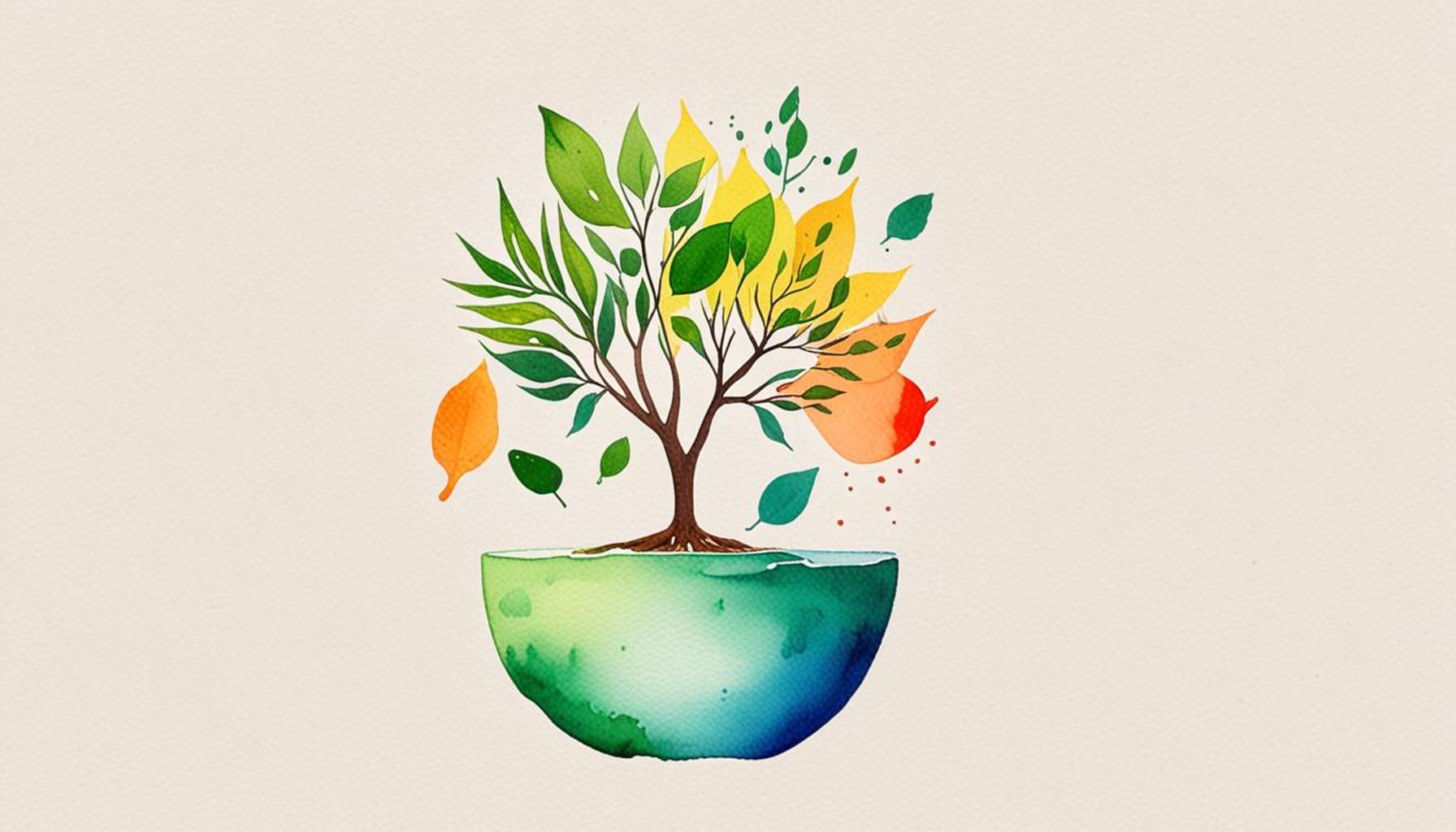Simple Aesthetics and Sustainability: How Minimalism Can Contribute to an Ecological Lifestyle

Exploring Minimalism and Environmental Impact
In today’s fast-paced world, the quest for simplicity resonates with many individuals. Minimalism offers a pathway not just to a clearer mind, but also to a more sustainable lifestyle. While the term “minimalism” often evokes images of stark white spaces and sparsely furnished homes, its true essence lies in the intentionality behind our choices. Individuals adopting a minimalist approach find themselves not just decluttering their physical spaces but redefining their relationship with consumption and, by extension, the environment.
As consumers increasingly recognize the environmental consequences of their choices, they are seeking ways to reduce their ecological footprints. Here are some key aspects of how minimalism intersects with sustainability:
- Reduced Consumption: Emphasizing quality over quantity, minimalism encourages individuals to purchase fewer items. For instance, rather than acquiring the latest phone model each year, minimalists may opt to keep devices longer and invest in high-quality, durable products. This shift not only conserves resources but also reduces waste associated with frequent manufacturing.
- Eco-Friendly Designs: Minimalist aesthetics often prioritize sustainable materials and products. An increasing number of brands are embracing designs that focus on eco-friendly materials such as bamboo, recycled plastics, and organic fibers. Furniture companies, like IKEA, are now introducing collections that highlight sustainability while maintaining a minimalist aesthetic, proving that style and conscience can coexist harmoniously.
- Waste Reduction: A minimalist approach advocates for living with less, leading to decreased waste generation. By consciously avoiding items that contribute to short-term gratification, individuals tend to foster habits that favor reuse, recycling, and upcycling. For instance, choosing to buy second-hand clothing instead of new can significantly reduce the fashion industry’s impact on landfills.
By embracing a more streamlined lifestyle, individuals are not only cleared of clutter but also engage in practices that promote a healthier planet. Consider how simple aesthetics can contribute to larger sustainability goals. Communities across the United States are witnessing a shift towards local farming and gardening initiatives, where residents prioritize homegrown produce, further aligning with a minimalist ethos of self-sufficiency and environmental mindfulness.
Unpacking the relationship between minimalism and ecology reveals innovative solutions to modern issues. Through thoughtful living choices, it is possible to foster a more harmonious existence with our environment. For those intrigued by this lifestyle shift, exploring resources like documentaries and books on minimalism may provide deeper insights into the benefits of curating not only one’s possessions but also one’s relationship with the Earth. Ultimately, minimalism is not merely a trend; it is a movement towards deliberate living that champions sustainability and mindful consumption.
UNCOVER MORE: Click here to dive deeper

Embracing Simplicity for a Sustainable Future
The essence of minimalism extends beyond mere aesthetic choices; it embodies a philosophy of intentional living that significantly impacts our ecological footprint. By consciously choosing what to keep and what to let go, minimalism fosters a mindset that prioritizes sustainability. This approach simultaneously encourages individuals to reflect on their everyday choices, leading to a profound understanding of how these decisions affect the planet.
An essential aspect of minimalism is its focus on mindful consumption. Rather than pursuing fleeting trends, minimalists often seek items with lasting value. This transition is critical when considering that the production of goods results in substantial environmental degradation. According to a report by the Environmental Protection Agency, household waste in the United States amounted to approximately 292.4 million tons in 2018, with a significant portion originating from fast fashion and electronic goods. By choosing to invest in durable, timeless products, minimalists can directly combat this trend and reduce waste.
Moreover, minimalism advocates for localism as a way to reduce transportation emissions and promote community resilience. Individuals who adopt minimalist principles often find themselves gravitating towards local farmers’ markets, where they can support sustainable agriculture while enjoying fresher, chemical-free produce. This practice not only encourages a healthier diet but also aligns with ecological initiatives aimed at preserving local ecosystems and biodiversity. The Farmer’s Market Coalition states that local food production can create up to three times more jobs in the community compared to large-scale industrial farming practices, showcasing the socio-economic benefits of this lifestyle.
In addition to these lifestyle adjustments, minimalism embraces versatility and multifunctionality in design. The trend of opting for fewer, yet more versatile items can substantially diminish the demand for new products. For instance, a minimalist kitchen may prioritize a few essential tools that serve multiple purposes, such as a classic cast-iron skillet that can be used for baking, frying, and simmering. This approach not only simplifies daily tasks but drastically cuts down on the consumption of unnecessary goods.
But the relationship between minimalism and sustainability is not restricted to individual choices; it extends to broader social implications as well. As more individuals choose to live simply, communities can evolve to cultivate spaces that reflect these values. Public spaces, inclusive parks, and community gardens can emerge from a collective desire for reduced consumption and increased awareness about ecological impact. Such shared initiatives encourage collaboration, forming tighter bonds among residents while fostering a connection to the environment.
By understanding these interconnected aspects of minimalism and sustainability, individuals are empowered to take actionable steps towards an ecological lifestyle. Not only does embracing simplicity aid in clearing physical and mental clutter, but it also promotes a thriving planet. As we explore the nuances of this movement, it becomes evident that minimalism doesn’t just reshape our living spaces—it has the potential to inspire significant change within our communities and beyond.
| Advantages | Description |
|---|---|
| Reduced Consumption | Minimalism encourages mindful consumption, leading to less waste and a lower carbon footprint. |
| Simplified Living Spaces | Embracing a minimalist aesthetic results in clean, sustainable spaces that promote well-being and harmony with nature. |
The connection between minimalism and sustainability is profound. By prioritizing simple aesthetics, individuals can create environments that are not only visually appealing but also ecologically sound. One core principle of minimalism is to limit possessions and clutter, which naturally translates to a reduction in resource consumption. This means fewer products being produced, thus minimizing the environmental impact associated with manufacturing processes.Moreover, spaces that embody minimalism often reflect a deeper connection to nature. By utilizing natural materials, such as wood and stone, and opting for eco-friendly furnishings, we align our living environments with our ecological values. This further promotes a lifestyle that is centered around sustainability and respects the planet’s resources.Incorporating minimalism into daily life not only enhances personal well-being but also contributes to the broader movement towards an ecological lifestyle. These choices lead to a ripple effect, inspiring others to evaluate their consumption habits and join the cause for a healthier planet.
DISCOVER MORE: Click here for insights on minimalist organization
Reducing Waste Through Thoughtful Design
Another compelling dimension where minimalism intersects with sustainability is through the lens of waste reduction. In a world increasingly plagued by overflowing landfills and single-use plastics, the minimalist philosophy advocates for a shift towards designs that prioritize longevity and recyclability. This approach challenges consumers to reconsider not only the number of items they acquire but also the lifecycle of the products they choose.
For instance, brands that embrace minimalist values often leverage upcycled materials and sustainable production practices. A growing number of companies in the US specialize in crafting items from discarded materials—think furniture made from reclaimed wood or fashion produced from repurposed textiles. This transformation directly supports environmental efforts to minimize waste while also promoting creativity and innovation within design. According to the EPA, the recycling of one ton of paper can save more than 17 trees, demonstrating the tangible benefits of sustainable sourcing.
Lighting choices also exemplify this relationship between minimalism and sustainability. LED lighting, revered for its energy efficiency, has become a staple in minimalist interiors. These bulbs consume significantly less energy and last up to 25 times longer than traditional incandescent bulbs. By opting for such eco-friendly options, individuals can not only reduce their energy consumption but also cultivate a serene ambiance that epitomizes minimalist aesthetics.
Mindful Decluttering and Its Ecological Impact
The act of decluttering is foundational within the minimalist philosophy. However, it’s not merely about removing excess items; it’s about making informed decisions regarding their disposal. Reframing the conversation around decluttering encourages individuals to think critically about where their items end up. Instead of contributing to landfill overflow, many minimalists engage in donating or selling items. Charitable organizations like Goodwill and local thrift shops often welcome such contributions, ensuring that items are given a second life rather than being discarded. Online platforms, such as Poshmark or Facebook Marketplace, also facilitate the resale of goods, fostering a circular economy.
Additionally, the minimalist commitment to reducing excess can extend to digital spaces. As individuals strive for a simpler life, many find value in digital decluttering—streamlining their online presence and cutting down on unnecessary subscriptions and digital clutter. This mindful approach translates to reduced energy consumption as well, as data centers hosting cloud storage require significant electricity to operate.
Encouraging Conscious Community Engagement
Minimalism often cultivates a culture of community engagement. By embracing simpler living, individuals may feel less pressured to consume and more inclined to connect with their local environments. Community initiatives, such as seed swaps, clothing exchanges, and communal gardens, have sprouted across cities in the US, reflecting a collective effort towards sustainability while leveraging minimalism’s core tenets. Such programs not only reduce waste but also repurpose resources, build community ties, and educate individuals on sustainable practices.
Furthermore, these communal activities foster a sense of shared responsibility towards the environment. As community members engage in cooperative efforts, they raise awareness around the importance of mindful consumption and the ecological impacts of their choices. Through this collective spirit, styling one’s life around minimalism not only enriches personal well-being but also contributes to the broader goal of ecological sustainability.
UNLOCK YOUR POTENTIAL: Click here to discover how
Embracing Minimalism for a Sustainable Future
In conclusion, the synergy between minimalism and sustainability presents a powerful opportunity for individuals and communities to reshape their relationship with the environment. By prioritizing simple aesthetics that emphasize functionality and longevity, we can contribute to a more ecological lifestyle while finding beauty in less. The adoption of practices such as thoughtful consumption, mindful decluttering, and community engagement not only lessens our environmental footprint but also enriches our experiences and connections with one another.
As we consider the profound implications of our choices—ranging from the products we use to the communities we support—it becomes evident that minimalism is not merely a design philosophy but a way of life. It invites us to challenge the prevailing culture of overconsumption and wastefulness, encouraging instead a narrative of sustainability that champions waste reduction, upcycling, and shared resources.
Moreover, the movement towards minimalism can inspire a ripple effect, cultivating awareness and action within our circles. Engaging in local sustainability initiatives and recognizing the power of collective efforts can further foster a sense of responsibility towards our ecosystems. Each step taken in minimizing our possessions or supporting sustainable practices can contribute to a larger transformation on a global scale.
Ultimately, the embrace of minimalist principles offers a pathway towards a more sustainable future; a future where aesthetics harmonize with ethics. As we embark on this journey, let us remain curious, strive for simplicity, and recognize the profound impact our choices can have on the planet. Together, we can cultivate a lifestyle that values ecological integrity and enriches life’s simplest pleasures.


